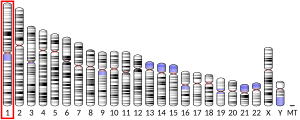LRRC7
Leucine rich repeat containing 7 also known as LRRC7, Densin-180, or LAP1 is a protein which in humans is encoded by the LRRC7 gene.[5]
Structure
Found to be densely associated to the postsynaptic density (PSD), it has been characterised as a 188 kDa (originally thought to be 180 kDa, hence nomenclature), 1495 residues long, brain-specific protein containing 16 leucine-rich repeats (LRRs) within the 500 N-terminal residues, and one Psd95/Discs large/Zona occludens (PDZ) domain within the 200 C-terminal residues. Originally postulated to have an apparent transmembrane domain, it has now been shown that the protein has numerous phosphorylation sites both N- and C-term of this domain, and that protein is therefore cytoplasmic; palmitoylation is thought to occur near the N-terminus of the protein which would account for localisation of the protein at the PSD.[6]
Interactions
LRRC7 has been shown to interact with CDH2.[7]
The currently exposed interactions of Densin-180 portray the protein as a promiscuous player amongst key synaptic players, fitting with the original observation of the protein’s dense presence among core PSD proteins by Mary B. Kennedy's Laboratory. Identified interaction partners include: CaMKII-alpha, alpha-Actinin and NR2B (via CaMKII-alpha), Cav1.3 (L-type Ca2+) channels, MAGUIN-1, Shank, PSD-95 (via Shank and MAGUIN-1), beta-Catenin, delta-Catenins and NCadherin (via the Catenins). The nature and function of these interactions, detailed in tables 1-1 and 1-2, portray Densin-180 as a key interactor in the midst of receptor proteins, scaffolding proteins and structural proteins. [number of sources - referenced in - Subcellular localisation of recombinant Densin-180 clones expressed in HEK293 TSA cells Ranatunga, J.M. (2011) Subcellular localisation of recombinant Densin-180 clones expressed in HEK293 TSA cells. Masters thesis, UCL (University College London). http://discovery.ucl.ac.uk/1322972/]
It is also quite possible that Densin-180 dimerises or multimerises through interactions between its PDZ domain and its own terminal amino acid residues. [Subcellular localisation of recombinant Densin-180 clones expressed in HEK293 TSA cells Ranatunga, J.M. (2011) Subcellular localisation of recombinant Densin-180 clones expressed in HEK293 TSA cells. Masters thesis, UCL (University College London). http://discovery.ucl.ac.uk/1322972/]
References
- ^ a b c GRCh38: Ensembl release 89: ENSG00000033122 – Ensembl, May 2017
- ^ a b c GRCm38: Ensembl release 89: ENSMUSG00000028176 – Ensembl, May 2017
- ^ "Human PubMed Reference:". National Center for Biotechnology Information, U.S. National Library of Medicine.
- ^ "Mouse PubMed Reference:". National Center for Biotechnology Information, U.S. National Library of Medicine.
- ^ "Entrez Gene: LRRC7 leucine rich repeat containing 7".
- ^ Thalhammer A, Trinidad JC, Burlingame AL, Schoepfer R (April 2009). "Densin-180: revised membrane topology, domain structure and phosphorylation status". J. Neurochem. 109 (2): 297–302. doi:10.1111/j.1471-4159.2009.05951.x. PMC 2846389. PMID 19187442.
- ^ Izawa, Ichiro; Nishizawa Miwako; Ohtakara Kazuhiro; Inagaki Masaki (Feb 2002). "Densin-180 interacts with delta-catenin/neural plakophilin-related armadillo repeat protein at synapses". J. Biol. Chem. 277 (7). United States: 5345–50. doi:10.1074/jbc.M110052200. ISSN 0021-9258. PMID 11729199.
Further reading
- Apperson ML, Moon IS, Kennedy MB (1996). "Characterization of densin-180, a new brain-specific synaptic protein of the O-sialoglycoprotein family". J. Neurosci. 16 (21): 6839–52. doi:10.1523/JNEUROSCI.16-21-06839.1996. PMC 6579252. PMID 8824323.
- Nagase T, Kikuno R, Ishikawa KI, et al. (2000). "Prediction of the coding sequences of unidentified human genes. XVI. The complete sequences of 150 new cDNA clones from brain which code for large proteins in vitro". DNA Res. 7 (1): 65–73. doi:10.1093/dnares/7.1.65. PMID 10718198.
- Walikonis RS, Oguni A, Khorosheva EM, et al. (2001). "Densin-180 forms a ternary complex with the (alpha)-subunit of Ca2+/calmodulin-dependent protein kinase II and (alpha)-actinin". J. Neurosci. 21 (2): 423–33. doi:10.1523/JNEUROSCI.21-02-00423.2001. PMC 6763799. PMID 11160423.
- Izawa I, Nishizawa M, Ohtakara K, Inagaki M (2002). "Densin-180 interacts with delta-catenin/neural plakophilin-related armadillo repeat protein at synapses". J. Biol. Chem. 277 (7): 5345–50. doi:10.1074/jbc.M110052200. PMID 11729199.
- Ohtakara K, Nishizawa M, Izawa I, et al. (2003). "Densin-180, a synaptic protein, links to PSD-95 through its direct interaction with MAGUIN-1". Genes Cells. 7 (11): 1149–60. doi:10.1046/j.1365-2443.2002.00589.x. PMID 12390249.
- Wang L, Xu J, Wu Q, et al. (2003). "Cloning and characterization of a novel splice variant of the brain-specific protein densin-180". Int. J. Mol. Med. 11 (2): 257–60. doi:10.3892/ijmm.11.2.257. PMID 12525888.
- Ahola H, Heikkilä E, Aström E, et al. (2003). "A novel protein, densin, expressed by glomerular podocytes". J. Am. Soc. Nephrol. 14 (7): 1731–7. doi:10.1097/01.ASN.0000075553.33781.9F. PMID 12819232.
- Goodchild RE, Dauer WT (2005). "The AAA+ protein torsinA interacts with a conserved domain present in LAP1 and a novel ER protein". J. Cell Biol. 168 (6): 855–62. doi:10.1083/jcb.200411026. PMC 2171781. PMID 15767459.
- Robison AJ, Bass MA, Jiao Y, et al. (2005). "Multivalent interactions of calcium/calmodulin-dependent protein kinase II with the postsynaptic density proteins NR2B, densin-180, and alpha-actinin-2". J. Biol. Chem. 280 (42): 35329–36. doi:10.1074/jbc.M502191200. PMID 16120608.
- Gregory SG, Barlow KF, McLay KE, et al. (2006). "The DNA sequence and biological annotation of human chromosome 1". Nature. 441 (7091): 315–21. Bibcode:2006Natur.441..315G. doi:10.1038/nature04727. PMID 16710414.
- Rinta-Valkama J, Aaltonen P, Lassila M, et al. (2007). "Densin and filtrin in the pancreas and in the kidney, targets for humoral autoimmunity in patients with type 1 diabetes". Diabetes Metab. Res. Rev. 23 (2): 119–26. doi:10.1002/dmrr.655. PMID 16741999. S2CID 30494486.
- Lassila M, Juhila J, Heikkilä E, Holthöfer H (2007). "Densin is a novel cell membrane protein of Sertoli cells in the testis". Mol. Reprod. Dev. 74 (5): 641–5. doi:10.1002/mrd.20659. PMID 17039495. S2CID 43409823.
- Ewing RM, Chu P, Elisma F, et al. (2007). "Large-scale mapping of human protein-protein interactions by mass spectrometry". Mol. Syst. Biol. 3 (1): 89. doi:10.1038/msb4100134. PMC 1847948. PMID 17353931.
- Heikkilä E, Ristola M, Endlich K, et al. (2007). "Densin and beta-catenin form a complex and co-localize in cultured podocyte cell junctions". Mol. Cell. Biochem. 305 (1–2): 9–18. doi:10.1007/s11010-007-9522-6. PMID 17581699. S2CID 31301047.
Add—a very detailed thesis with preliminary experiments and theories about the function of Densin-180 entitled Subcellular localisation of recombinant Densin-180 clones expressed in HEK293 TSA cells
http://discovery.ucl.ac.uk/1322972/



